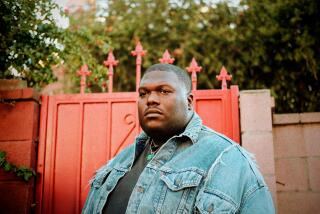Westwood Gunman Convicted : Crime: The murder of Karen Toshima led to widespread news coverage of gang violence. Her killer faces 27 years to life.
- Share via
A gang member was convicted Wednesday of the 1988 murder of Karen Toshima, whose death on a Westwood street stunned Los Angeles and brought the gang violence problem to center stage in the city.
After two days of deliberations, a Santa Monica Superior Court jury found Durrell Dewitt Collins, 23, guilty of the first-degree murder of Toshima and the attempted murder of rival gang member Tyrone Swain.
Collins, who showed no emotion as the verdicts were read, will be sentenced Dec. 1 by Superior Court Judge James Albracht. He faces 27 years to life for the murder and a life sentence for the attempted murder.
Deputy Dist. Atty. Michael Duarte said Collins will have to serve at least 17 years before he is eligible for parole.
Toshima, 27, a graphic artist from Long Beach, was shot Jan. 30, 1988, as she walked along a street in Westwood Village--long a magnet for crowds because of its movie theaters, fashionable shops and famous restaurants.
Toshima died a day after the shooting after a night on life-support systems.
None of Toshima’s family was present when the verdict was read, but her brother, Kevin, said in a telephone interview later: “I guess it sort of puts an end to the ordeal. It’s like a final chapter to it all. I am ready to go on living my life, and my parents are, too.”
After the verdict was announced, jurors said they based their decision in large part on the testimony of eyewitnesses who identified Collins as the man who fired the fatal shot.
According to testimony during the five-week trial, members of two rival Crips factions had fought earlier that night in Westwood. They gathered in separate parking lots across Broxton Avenue and continued to argue. Then Swain crossed the street, advancing on Collins’ group carrying a plastic milk crate.
Witnesses said Collins yelled, “C’mon, I got something for you,” then pulled a gun and fired twice at Swain, missing him, but hitting Toshima once in the head.
Collins was among dozens of bystanders rounded up that night and questioned by police, then released. His picture was taken, along with several other suspected gang members, and shown to eyewitnesses, and it was their identification of him that led to his arrest a week later at the Southwest Los Angeles home he shared with his father.
The case hinged on the testimony of the eyewitnesses, because there was little physical evidence linking Collins to the killing. The gun was recovered two days later, hidden in the ivy near UCLA, but no fingerprints were found on it.
But four eyewitnesses testified that they saw Collins pull the trigger--all from different vantage points along Broxton Avenue.
Jury foreman Penny L. Larson noted that the eyewitnesses “all had good vantage points” to view the shooting.
“They were just panoramic around him,” Larson said. “For the defense to have had a case, everyone on the prosecution would have had to have lied.”
Larson said the fact that Collins fired twice helped edge the jury toward its first-degree murder verdict rather than second-degree or voluntary manslaughter, which they also considered.
Larson said the jury took two votes to convict Collins and went through each witnesses’ testimony methodically. “The general consensus was that he was guilty, but no one wanted to make any rash decisions.”
Though the murder generated considerable news coverage, jurors said they were not swayed by the publicity.
“We weren’t setting out to make an example,” said one juror, who did not want his name used. “Trying to send a message wasn’t our intent at all. We just wanted to make the right decision.”
But Los Angeles Police Detective Will Thurston, one of the chief investigators on the case, said he hopes the verdict will indeed send a message.
“This was an important case because it showed the random nature of gang violence in the city of Los Angeles,” Thurston said. “I hope it sends a strong message to the people, loud and clear, that we’re not going to put up with it anymore, that we’re tired of gangs and the senseless gang-related shootings.”
Prosecutor Duarte said he is gratified that the jury gave the eyewitness testimony such credence. “Eyewitness cases are among the most difficult to try,” he said, “but I felt all along that we had a strong case.
“One of the major things in our favor was his consciousness of guilt, the things he did after the shooting, like change his hair style and turn his jacket inside out so he wouldn’t be identified.”
Collins’ family was present throughout the trial but arrived at court moments after the verdict was read.
When his father, who had testified during the trial that he did not believe young Collins was a gang member, learned that his son had been found guilty of murder, he hung his head over a rail in the empty courtroom and cried.
BACKGROUND
The January, 1988, shooting death of Karen Toshima, a young Long Beach woman who wandered into the path of a gang member’s bullet while strolling down a Westwood street with her boyfriend, galvanized the city and shocked it into a new reality--that escalating gang violence was no longer contained to poor and minority neighborhoods in South and East Los Angeles. Police changed their tactics and redoubled their efforts to combat gang violence citywide.
More to Read
Sign up for Essential California
The most important California stories and recommendations in your inbox every morning.
You may occasionally receive promotional content from the Los Angeles Times.













